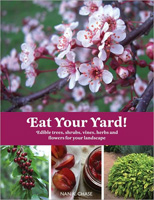Edible Landscaping: Beautiful and Delicious
Review by Maureen Halsema

Eat Your Yard!
Plump cherries ripe for picking, weighty pears begging to be plucked, aromatic lavender ready to be gathered—all within the confines of your yard!
Nan K. Chase shares how to plant, manage and prepare these delectable plants in her book, “Eat Your Yard! Edible trees, shrubs, vines, herbs and flowers for your landscape,” (Gibbs Smith, $19.99) released this year.
It is a cookbook, a gardening guide and a storybook all in one beautifully packaged, visually-compelling
arrangement. “The edible yard
combines beauty and practicality: beautiful form in the garden with bounteous crops to eat fresh or preserve for year-round enjoyment,” Chase writes.
Chase’s pas- sion for gardening is punctuated in each word, an enthusiasm that has been cultivated since she was a toddler playing in her parent’s fruit trees in California. Now, she can climb into the branches of her own trees in North Carolina and snack on the fruits of her labors. Chase has developed a strong relationship with her plants, as gardeners do, one that she cherishes.
“After all, fruit trees are like children: they need sunshine and fresh air, dry feet, balanced nutrition, and an occasional haircut. Then they’ll grow up big and strong,” Chase writes.
Chase selected 35 plants, both com- mon and exotic, that are versatile in the kitchen, pleasing to the palette, aesthetically rich through- out each season and most are capable of thriving in Southern Appalachia, particularly in Western North Carolina.
With each chapter, Chase unfolds a new possibility: favorite fruits, nuts and berries, and herbs and vines. From pears to kumquats to sunflowers, Chase has a special connection with each plant she describes. Sharing stories from her lifetime or from notable historical references, she makes each plant significant in its own way and reveals important lessons learned from edible landscaping.
Chase gives insider advice on which plants are simple to cultivate, such as blueberries, and which plants pose a greater challenge, like peach trees. For each possibility, Chase also tells you whom to turn to in order to seek fur- ther guidance as you start to grow your own edible landscape.
In addition to where, why and how to grow each plant, Chase includes some of her favorite recipes. Although I have yet to create my own edible garden, I cannot wait to cook up a stack of orange-almond pancakes or bake some of Nan’s fresh herb popovers.
So, even if you cannot have a large farm, you can still self-sustain and satisfy your taste buds with your own edible landscape. Peruse the pages of this useful book, pick up some seeds, grab your trowel and get to work. In a few short seasons your garden can be a delicious display of fruits, nuts, vines and herbs.
Bon appétit!
Related Articles
Latest News

Leave a comment
Your email address will not be published. Required fields are marked *




